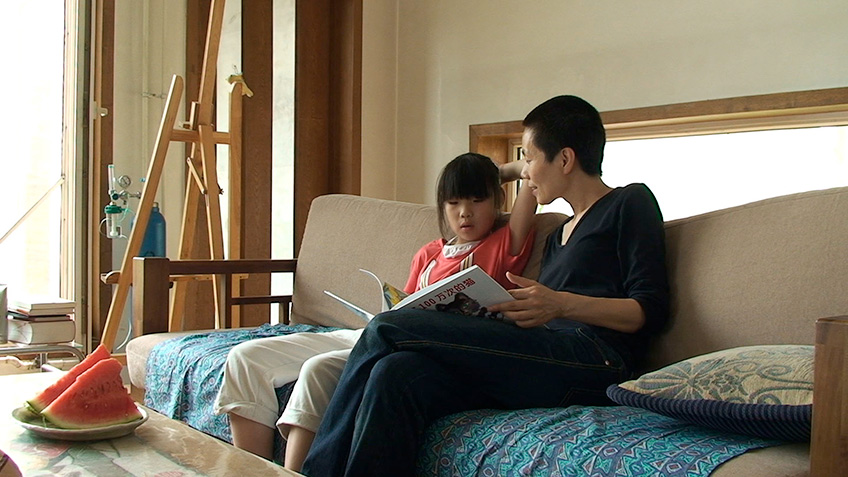백만 번 산 고양이The Cat that Lived a Million Times
고타니 타다스케
- Japan
- 2012
- 91min
- DCP
- color
Synopsis
영화는 사노 요코의 대표작인 그림책 『백만 번 산 고양이』를 소리 내어 읽으며 사람들이 그들의 삶과 죽음에 대해 이야기하는 모습을 보여준다. 한편 암 선고를 받은 작가 사노는 얼마 남지 않은 삶을 소중히 여기며 살아간다. 공통점이 없는 이들을 하나로 이어주는 것은 사노의 책이다. 영화는 또한 사노가 지냈던 베이징과 도쿄의 풍경을 통해서 죽음의 그림자와 새로운 생명의 풍경을 담아낸다.
Review
“고양이가 죽었을 때 100만 명의 사람들이 울지만 고양이는 한 번도 울지 않았습니다...” 암으로 죽기 1년 전 사노 요코는 얼굴을 찍지 않는다는 조건으로 인터뷰를 시작한다. 어린 시절 그림을 잘 그렸던 오빠가 죽고 난 뒤 사람마다 운명이 있다고 믿게 됐다는 그녀.
“삶에 미련은 없어요. 태어나겠다고 선택한 적도 없고 삶은 고되죠. 난 꼭 사는 게 좋은 거라고 생각하진 않아요.” 영원히 살 수 없다는 걸 알면서 이 책의 의미를 알았다는 독자, 죽음을 앞두고 어린 딸에게 자신의 죽음을 설명하기 위해 이 책을 읽어주겠다는 독자, 살고 싶어 매번 자해한다는 독자들은 각기 다른 이유로 이 책을 사랑한다. 왕과 선원, 마술사 혹은 어린 소녀의 고양이였지만 매번 그들을 미워했던 고양이는 어느 날 비로소 그 누구의 고양이도 아닌 자기 자신의 고양이가 되어 흰 털 고양이를 만난다.
“내 가족이 조금씩 와해되는 동안, 나는 한 고양이가 다른 고양이를 만나 가족을 만들고 죽어가는 단순한 스토리를 만들었어요. 그게 『백만 번 산 고양이』였어요. 나는 많은 사람들이 이런 원초적인 것들을 원한다는 걸 알았고 다른 누구보다도 내게 그것이 필요했어요.”
“어느 날 흰 고양이는 조용히 움직이지 않게 되었습니다. 고양이는 처음으로 울었습니다...”
2010년 5월, 사노 요코는 72세로 생을 마감한다. 백 만 번 산 고양이가 사랑하는 흰 털 고양이를 만나 다시는 살아 돌아오지 않은 것처럼, 그녀도 그곳에서 사랑하는 사람들을 만났을까? [이정은]
Director
-

고타니 타다스케Kotani Tadasuke
The Legacy of Frida Kahlo (2015)The Cat That Lived a Million Times (2012)Line (2008)Good Girl (2006)Lullaby (2002) In 2008, Yoko Sano, a picture novelist, announced in her autobiography that she got cancer. When I read it I was seized with the impulse to meet with her. “I let you make a film about me if my image will not appear on.” was her word when I first visited her. About one year has passed since then and I have done nothing but broken myself into pieces in front of “simple” Yoko. Looking back and thinking, I didn’t pity her nor wanted to encourage her to fight against cancer∙∙∙. I just wanted to break my fixed ideas. There has been a tendency that people consider death as a negative thing, though I’d rather oppose it. Having said that, I might have admitted that death is negative. Yoko has broken ‘myths’ based on Japanese humanism or social justice after the war by creating picture novels about life-after-death of her young brothers, father and mother with whom relationship was difficult. Meeting with such a person for a year has made me confused and felt myself being broken. After the destruction, the next step is regeneration. One of Yoko’s famous novels “The cat with a million lives” was published in 1977 and I was born in this year. My mother used to read it for me. The story about death and life of the cat was very scaring to me. It clearly showed that every living thing will die. I visited various people to collect their life-after-death stories along with interviewing Yoko. A person who suffers from Gender Identity Disorder, a woman had a stillborn baby, a girl doesn’t know who are her parents, a woman visiting her uncle who suffers from cancer, a woman receiving artificial insemination therapy many times, wife of an artist who has been in a coma and widow and her children living in the house with pictures of her late husband everywhere and etc. Through talking with these people, I collected the life-after-death to shoot this film. This film is the process of the destruction and reproduction of a movie director through the picture novelist Yoko Sano and her readers.
Credit
- ProducerJames Crump
- Screenwriter James Crump
- Cinematography Christopher Felver, Harry Geller, Paul Lundahl, Eric Koziol, David Koh
- Editor David Giles
- Music J. Ralph
Contribution / World Sales
Contribution / World Sales CaRTe bLaNChe
Phone 33 977216777
E-mail entry@c-a-r-t-e-blanche.com


